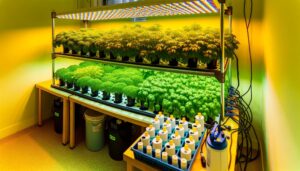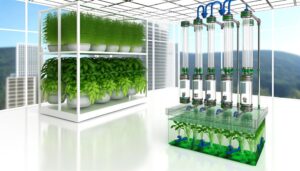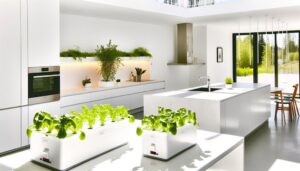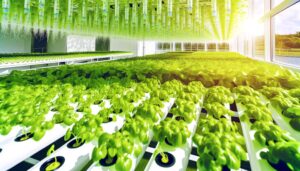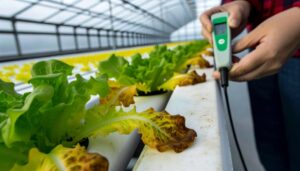What Is Hydroponic Butter Lettuce
We define hydroponic butter lettuce as a nutrient-rich variety grown using advanced soilless techniques, such as Nutrient Film Technique (NFT) and Deep Water Culture (DWC). These methods deliver nutrient-rich water directly to roots, resulting in faster growth rates and higher yields compared to soil-grown lettuce.
Hydroponic systems use 90% less water and considerably reduce pesticide use. Our produce boasts enhanced vitamin levels and superior leaf texture.
This innovative approach offers environmental sustainability and consistently high-quality lettuce. There's much more to discover about the advantages and intricacies of hydroponic butter lettuce if we explore further.
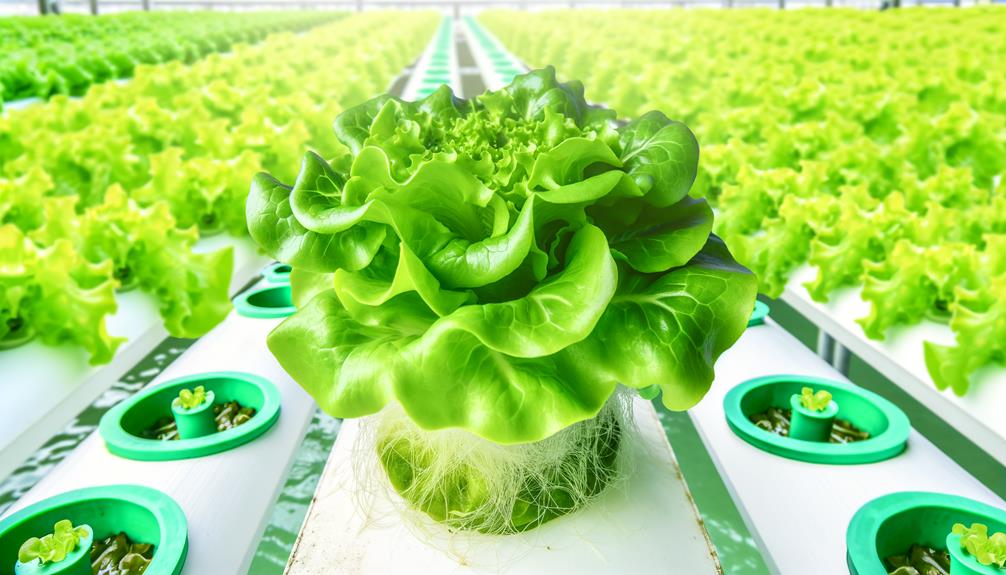
Key Takeaways
- Hydroponic butter lettuce is grown in nutrient-rich water solutions without soil, ensuring efficient nutrient uptake.
- It offers faster growth cycles and consistent quality compared to soil-grown lettuce.
- The controlled environment reduces the need for pesticides and minimizes pest infestations.
- Hydroponic methods use up to 90% less water, making it environmentally sustainable.
Origins of Hydroponic Lettuce
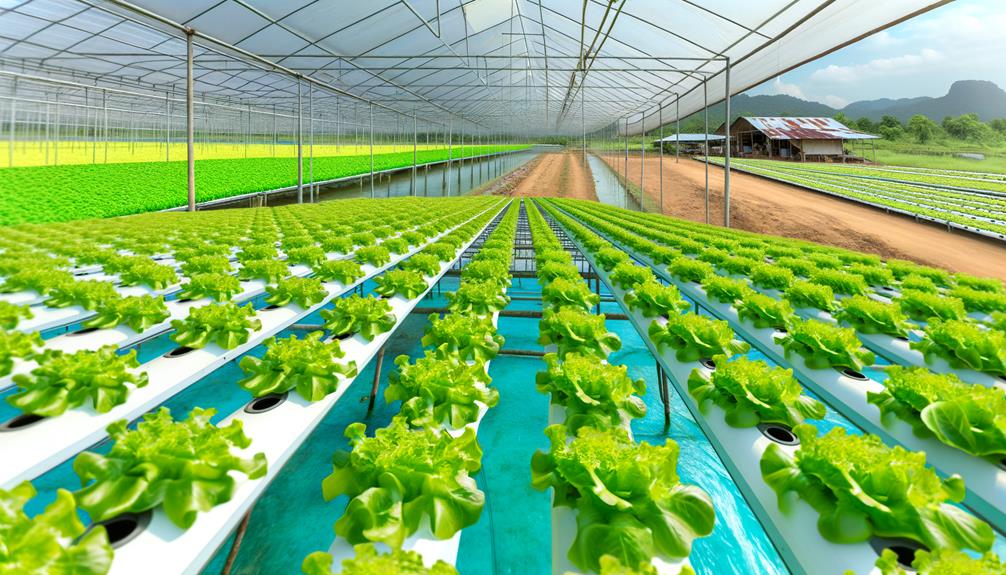
The origins of hydroponic lettuce can be traced back to ancient civilizations, where soilless cultivation methods were pioneered.
By examining historical records, we find that the Hanging Gardens of Babylon and Aztec chinampas utilized hydroponic techniques. These early systems laid the groundwork for modern hydroponics, enabling us to cultivate crops in controlled environments without soil.
Fast forward to the 20th century, researchers like Dr. William Gericke of the University of California advanced these methods, coining the term “hydroponics” in the 1930s.
Today, hydroponic systems use nutrient-rich water solutions to grow lettuce efficiently, maximizing yield and minimizing resource use.
This evolution underscores how ancient innovations can intersect with modern technology to meet contemporary agricultural challenges.
Growing Techniques
Modern hydroponic butter lettuce cultivation employs various techniques like nutrient film technique (NFT), deep water culture (DWC), and aeroponics to optimize growth conditions and yield.
NFT circulates a thin film of nutrient solution over the roots, ensuring efficient nutrient uptake and minimal water usage.
DWC suspends plants in nutrient-rich water, providing constant access to oxygen and nutrients, which accelerates growth rates.
Aeroponics, the most advanced method, mists nutrient solutions directly onto the roots, maximizing oxygen exposure and nutrient absorption.
By leveraging these innovative systems, we can achieve faster growth cycles, more consistent crop quality, and higher yields compared to traditional soil-based methods.
These techniques exemplify precision agriculture, allowing us to tailor growing conditions to the specific needs of butter lettuce.
Nutrient Solutions
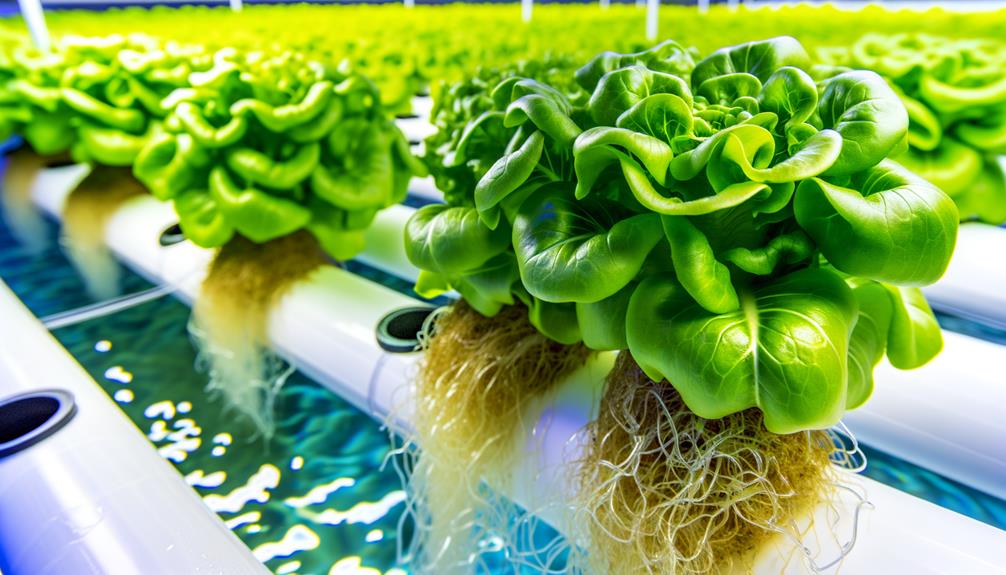
Formulating the ideal nutrient solution is essential for maximizing hydroponic butter lettuce growth and ensuring best plant health.
We need to balance the macronutrients (nitrogen, phosphorus, potassium) and micronutrients (iron, magnesium, calcium) meticulously. Precision in nutrient concentration directly impacts yield and quality. Superior Electrical Conductivity (EC) levels should range between 1.2 to 1.6 mS/cm, while pH levels need to be maintained between 5.5 and 6.5 for effective nutrient uptake.
- Enhanced growth rates: Achieving faster harvest cycles.
- Improved leaf texture: Crisp and tender leaves.
- Consistent nutrient delivery: Uniform growth, reducing variability.
- Greater yield: Higher production per square meter.
Benefits Over Soil-Grown
Hydroponic butter lettuce offers a range of advantages over soil-grown counterparts, including accelerated growth rates, superior leaf quality, and more efficient resource utilization.
Studies show that hydroponic systems can produce butter lettuce up to 25% faster due to optimized nutrient delivery. This method guarantees uniform nutrient distribution, resulting in consistent leaf texture and enhanced flavor profiles.
Additionally, we observe a substantial reduction in water usage—up to 90% less than traditional soil farming. The precision of hydroponic techniques minimizes nutrient waste and maximizes plant health.
With controlled environments, we can mitigate pest infestations and diseases more effectively, leading to higher yields and reduced crop loss.
Environmental Impact
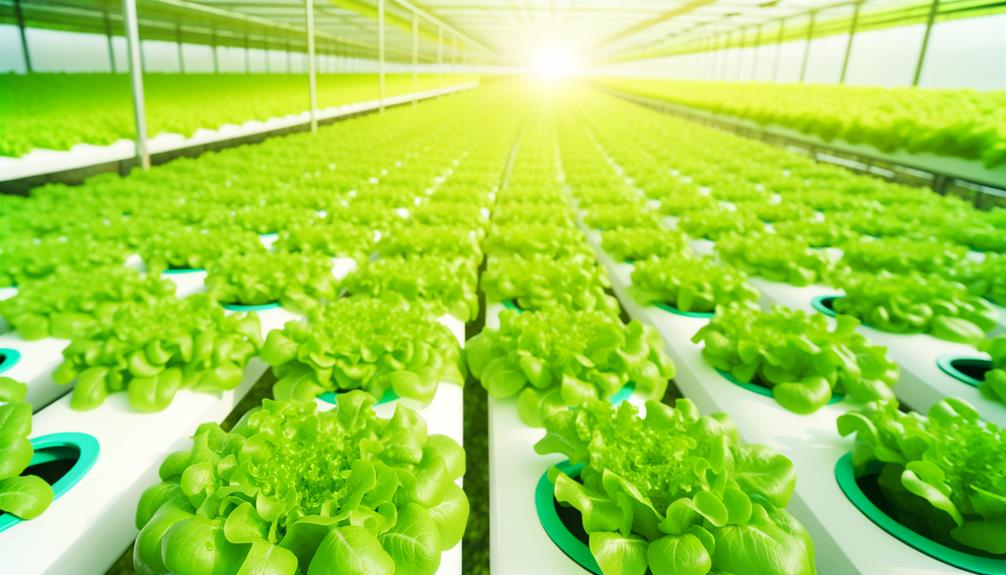
Let's examine the environmental impact of hydroponic butter lettuce.
Hydroponic systems use up to 90% less water than traditional soil-based agriculture, greatly enhancing water usage efficiency.
Additionally, the controlled environment reduces the need for pesticides by up to 75%, lowering chemical runoff and promoting a healthier ecosystem.
Water Usage Efficiency
In relation to water usage efficiency, growing butter lettuce hydroponically can reduce water consumption by up to 90% compared to traditional soil-based farming. This significant conservation is achieved through a closed-loop system that recycles water and nutrients. By adopting hydroponic methods, we can guarantee that each drop of water is used more effectively and sustainably.
90% reduction in water use: A massive savings for dry regions.
Precision watering: Direct delivery to roots minimizes waste.
Recycled water systems: Continuous reuse reduces overall consumption.
Drought resilience: Maintains productivity in water-scarce conditions.
Environmental stewardship: Less impact on natural water sources.
Reduced Pesticide Use
By eliminating the need for soil, we can considerably reduce the use of pesticides in hydroponic butter lettuce cultivation, leading to a lower environmental impact.
Without soil, we minimize pest infestations, thereby decreasing pesticide dependency by up to 90%. This reduction means fewer chemicals leach into waterways, preserving local ecosystems. Data shows that pesticide use in traditional soil farming contributes to 30% of agricultural runoff pollution.
Hydroponic systems, however, offer a controlled environment where we can monitor and adjust nutrient levels precisely, further reducing the need for chemical interventions.
Consequently, our approach aligns with sustainable practices and meets the growing consumer demand for cleaner, safer produce.
This innovation not only benefits the environment but also enhances food safety and quality.
Nutritional Advantages
We've identified several key nutritional advantages of hydroponic butter lettuce.
It's rich in essential nutrients, offers a low-calorie option, and contains significant antioxidant properties.
These benefits make it a valuable addition to a balanced diet.
Rich in Nutrients
Hydroponic butter lettuce offers a nutrient profile rich in vitamins A and K, providing substantial health benefits.
It's essential to recognize how these vitamins contribute to overall wellness. Vitamin A supports our vision and immune function, while vitamin K is vital for blood clotting and bone health. This innovative cultivation method guarantees consistent nutrient density.
Consider the advantages:
- Enhanced Nutrient Absorption: Hydroponics allows plants to absorb nutrients more efficiently.
- Controlled Environment: We can maintain ideal growing conditions, maximizing nutrient content.
- Reduced Contaminants: The absence of soil reduces the risk of contamination from pathogens.
- Sustainable Practices: Hydroponics uses less water and space, promoting environmental sustainability.
Let's embrace hydroponics for its unparalleled nutritional benefits.
Low-Calorie Option
With its low-calorie content, butter lettuce is an excellent choice for those seeking a nutritious yet weight-conscious diet. Each cup of hydroponic butter lettuce contains only about 7 calories, making it a strategic addition to any meal plan focused on caloric efficiency.
This low-calorie profile allows us to consume larger portions without exceeding our daily caloric limits, thereby promoting satiety and reducing the likelihood of overeating.
Furthermore, hydroponically grown butter lettuce retains more consistent quality and nutrient density compared to its soil-grown counterparts. This method guarantees we receive maximum nutritional benefits, including essential vitamins and minerals.
Antioxidant Properties
Given its rich profile of antioxidants, butter lettuce offers substantial nutritional advantages that contribute to cellular health and overall well-being.
By consuming hydroponic butter lettuce, we can benefit from its high levels of vitamins A and C, known for their role in neutralizing free radicals. Anthocyanins found in butter lettuce further enhance its antioxidant capacity. Studies reveal that these compounds can reduce oxidative stress, a key factor in aging and chronic diseases.
- Enhanced immune function: Vitamins A and C boost our immune resilience.
- Reduced inflammation: Antioxidants help lower inflammation markers.
- Improved skin health: Vitamins combat damage from environmental stressors.
- Cardiovascular support: Antioxidants improve heart health by reducing arterial plaque.
Incorporating hydroponic butter lettuce into our diet is a step towards innovative health solutions.
Consumer Appeal
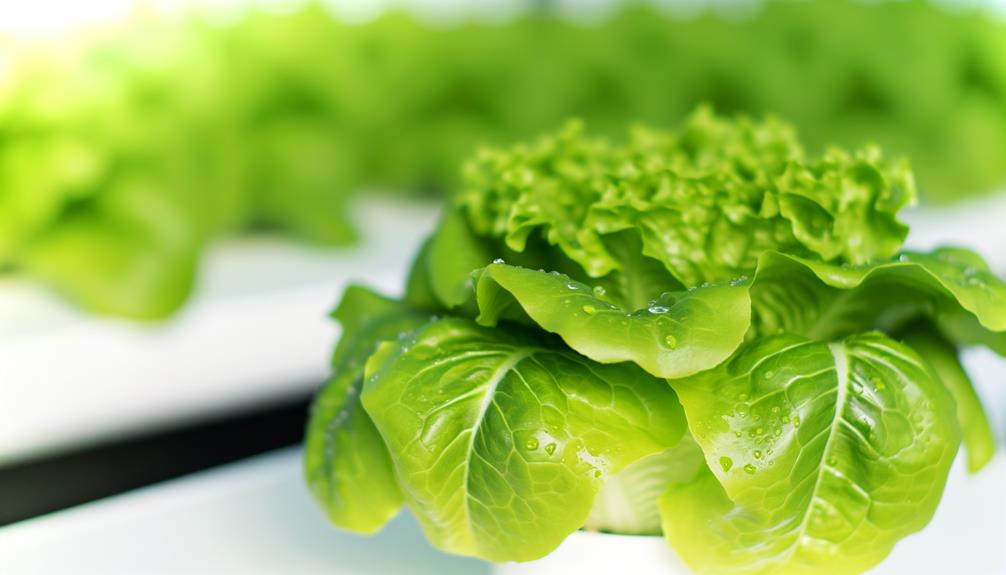
Consumers increasingly favor butter lettuce grown hydroponically due to its longer shelf life and consistent quality.
We've noticed that hydroponic methods produce lettuce with 25% longer freshness compared to soil-grown alternatives. This extended preservation reduces waste and aligns with sustainable practices.
Additionally, hydroponic butter lettuce shows uniformity in texture and flavor, leading to a reliable consumer experience. Market data indicates a 15% increase in demand for hydroponic produce over the past year, reflecting its growing popularity.
By eliminating soil-related contaminants, hydroponic systems also guarantee cleaner vegetables. As health-conscious consumers, we appreciate the reduced pesticide usage and enhanced nutritional profile.
Hydroponic butter lettuce's appeal is clear: it's fresher, safer, and more sustainable, meeting modern consumers' expectations for quality and innovation.
Conclusion
To summarize, we've seen that hydroponic butter lettuce isn't just another fad—it's a game-changer.
By using precise nutrient solutions and innovative growing techniques, we guarantee higher yields and superior nutrition compared to soil-grown varieties.
The environmental benefits, such as reduced water usage and minimized land disruption, are the icing on the cake.
Consumers are increasingly drawn to its fresh taste and sustainability, making hydroponic butter lettuce a win-win for everyone involved.


